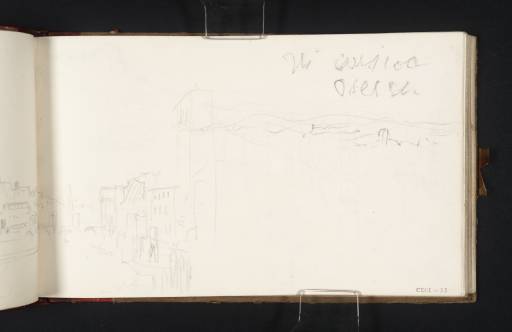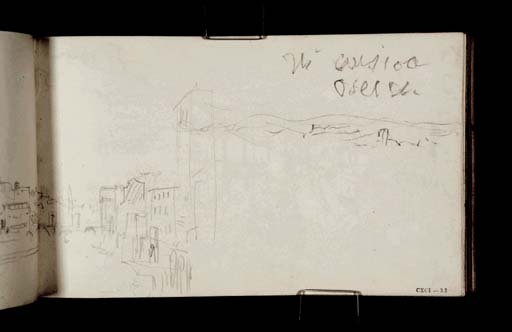Joseph Mallord William Turner View of the River Arno, Florence, with the Ponte alle Grazie; and Part of a View from Ossaia 1819
Image 1 of 2
Joseph Mallord William Turner,
View of the River Arno, Florence, with the Ponte alle Grazie; and Part of a View from Ossaia
1819
Joseph Mallord William Turner 1775–1851
Folio 33 Recto:
View of the River Arno, Florence, with the Ponte alle Grazie; and Part of a View from Ossaia 1819
D16546
Turner Bequest CXCI 33
Turner Bequest CXCI 33
Pencil on white wove paper, 113 x 189 mm
Inscribed by the artist in pencil ‘The Ossioa | Osessia’ top right
Stamped in black ‘CXCI 33’ bottom right
Stamped in black ‘CXCI 33’ bottom right
Accepted by the nation as part of the Turner Bequest 1856
References
1909
A.J. Finberg, A Complete Inventory of the Drawings of the Turner Bequest, London 1909, vol.I, p.568, as ‘Ponte Vecchio, with the Palazzo Pitti and Boboli Gardens beyond’.
1984
Cecilia Powell, ‘Turner on Classic Ground: His Visits to Central and Southern Italy and Related Paintings and Drawings’, unpublished Ph.D thesis, Courtauld Institute of Art, University of London 1984, pp.205 note 27, 207 note 38, 429, as ‘Florence from the lungarno near Ponte S. Niccolò’.
1987
Cecilia Powell, Turner in the South: Rome, Naples, Florence, New Haven and London 1987, p.92 note 18, 94 note 26.
During the eighteenth and nineteenth centuries, one of the most popular experiences for English visitors to Florence was to walk along the streets which lined the banks of the River Arno, known as the lungarni.1 Many of Turner’s sketches of the city depict views taken from these riverside thoroughfares. The study on the left-hand side of this page represents part of a prospect from the northern bank near present-day Piazza Piave and Ponte San Niccolò, looking downstream (west) towards Ponte alle Grazie.2 During Turner’s day this historic bridge was punctuated by buildings over the supporting piers, but these were removed during the late nineteenth century and the crossing itself destroyed during the Second World War. Rising beyond the bridge is the campanile of the Basilica of Santo Spirito. The composition spills over onto the opposite sheet of the double-page spread, see folio 32 verso (D16545). A related vista can be seen on folios 60a–61 (D16586–D16587).
Also on the page is a rough landscape sketch which appears to be the continuation of the composition on folio 29 (D16539). The artist has folded back the intervening pages in order to extend the vista on this sheet beneath. As his inscription indicates, the details represent part of a view from Ossaia, a village to the south of Cortona on the nineteenth-century route between Rome and Florence.
Also on the page is a rough landscape sketch which appears to be the continuation of the composition on folio 29 (D16539). The artist has folded back the intervening pages in order to extend the vista on this sheet beneath. As his inscription indicates, the details represent part of a view from Ossaia, a village to the south of Cortona on the nineteenth-century route between Rome and Florence.
Nicola Moorby
December 2010
How to cite
Nicola Moorby, ‘View of the River Arno, Florence, with the Ponte alle Grazie; and Part of a View from Ossaia 1819 by Joseph Mallord William Turner’, catalogue entry, December 2010, in David Blayney Brown (ed.), J.M.W. Turner: Sketchbooks, Drawings and Watercolours, Tate Research Publication, December 2012, https://www


